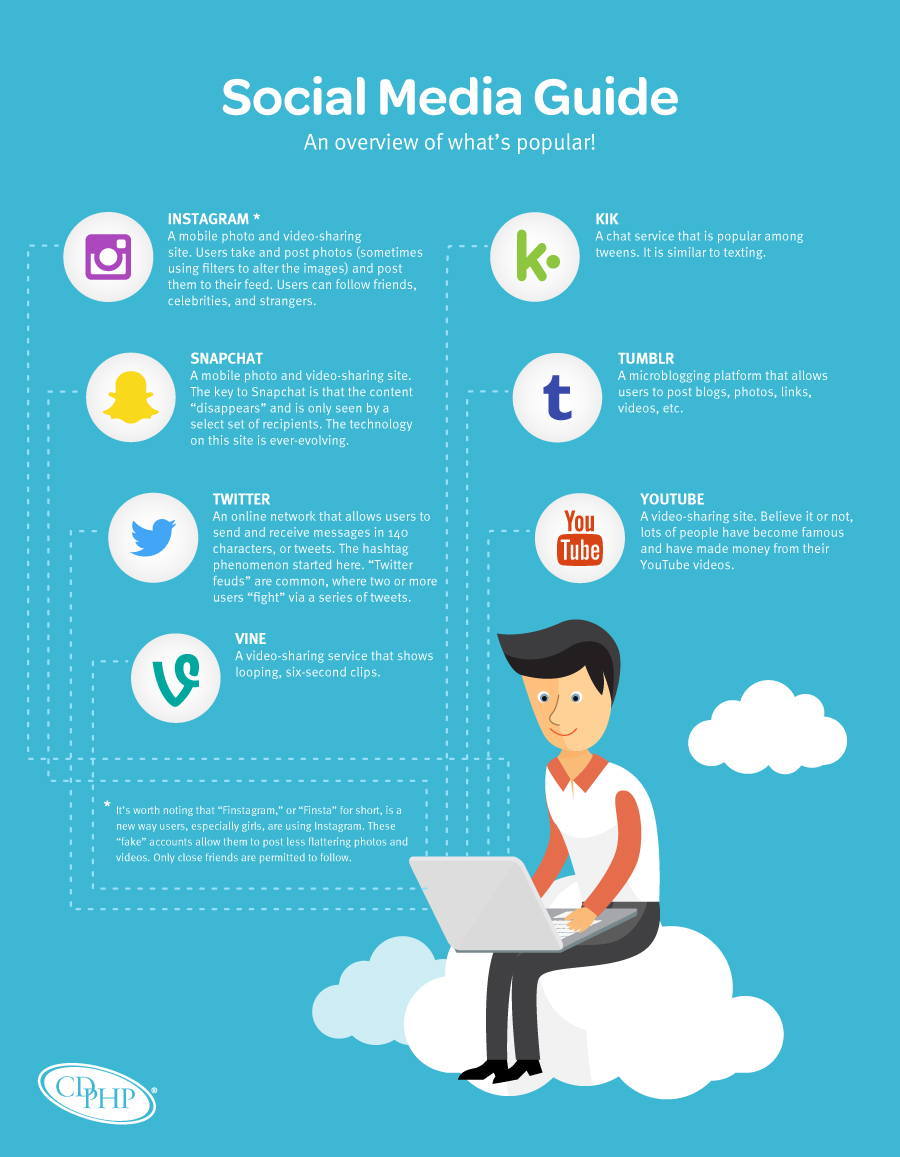A Parents’ Guide to Knowing Your Teens Online

If you are the parent of a teen (like I am), you can probably best identify your child by the top of his or her head. That’s because many teens today spend their time with their heads down and their face buried in some sort of mobile device – texting, tweeting, Snapchatting, gaming – the list goes on.
And by time, I mean a lot of it. A 2015 study by Common Sense Media found that daily screen time for tweens and teens adds up to nine hours a day. Yep, you read that right – NINE HOURS A DAY! That results in much more than just wasted hours. There are physical and psychological dangers your child could face.
Oh, my aching neck!
Let’s start with the most obvious problems that may arise from sitting in that hunched-over position: neck, shoulder, and back pain. Dubbed “text neck” by Florida chiropractor Dean Fishman, MD, the condition refers to the changes in posture that occur from sitting with your head forward. Looking down for prolonged periods of time can lead to muscle strain, nerve damage, back problems, and more.
And while the term “Blackberry thumb” has gone the way of the Blackberry, the potential for wrist and hand injuries has not. Texting, swiping, and the like are repetitive motions that can lead to inflammation and possible damage to tendons, ligaments, and nerves.
There are easy ways to prevent smartphone injuries. First and foremost – take a break! Encourage your children to be mindful of the time they are spending on their devices. Suggest they set an alarm to help them get into the habit of taking regular breaks.
When they do put the device down, have them sit up straight (or better yet, stand up) and stretch their neck, shoulders, and back. And don’t forget, kids learn by example. If you spend all of your time with your face in the phone, they will, too.
The zombie apocalypse is here
Parents, law enforcement, and government officials have been warning kids about the dangers of distracted driving for years. But there is a new danger lurking, and it is scarier than “The Walking Dead.” Called “Digital Deadwalkers” by the American Academy of Orthopaedic Surgeons, these distracted pedestrians can be found just about everywhere. And while mishaps become legendary Vines and viral videos, the injuries can be serious, even fatal. Texting, talking, listening to music, and scrolling through an Instagram feed are among the activities that divert kids’ attention from the simple act of walking.
Remind your kids to be aware of their surroundings, especially if they are walking in crowds, near stairs, or on the street. If they listen to music, have them keep the volume down so they can hear what is going on around them.
Sleep? Who needs sleep?
There’s no doubt we live in a 24/7 world, but you have to make sure your kids turn it off. The National Sleep Foundation says teens need between eight and 10 hours of sleep nightly. With school, homework, and extracurricular activities, there is hardly enough time in the day already. And remember, they are squeezing in that nine hours of screen time in between. That makes sleep a pretty low priority for many kids.
Numerous studies have shown that the light mobile devices emit can disrupt circadian rhythms, thus affecting the wake-sleep cycle. Keeping devices out of your kids’ rooms at night is ideal, but not always feasible. Instead, set a “lights out” rule – a time when your child must power down his or her device. Another option is to set the device’s “do not disturb” mode to turn off notifications during the nighttime hours.
‘Mean Girls’ and beyond
Online dangers can be just as bad – and in some cases, worse than – the physical ones. The explosion of social media – and the ability for kids to be anonymous – has provided numerous avenues for kids to become targets. The Cyberbullying Research Center reports that on average, about 26 percent of middle and high-school students have been cyberbullied, and the effects can be devastating. Trouble in school, drug and alcohol use, difficulty sleeping, and even suicide have been reported as a result.
Protecting your child is of the utmost importance. First and foremost, know the warning signs and watch for changes in your child’s behavior. Know what your kids are doing online. Make sure you have access to their online accounts and check in every once in a while. Check their privacy settings as well.
Most importantly, talk to your kids about bullying. Let them know who they can go to if they suspect cyberbullying. If your child is a victim, have them document the incident (save screenshots and text messages). If the threat is serious, talk to your child’s school administrators and law enforcement if necessary. If your child is the bully, explain the consequences of his or her actions and take action to stop it.
Cyberbullying isn’t the only online danger. In late 2015, CNN produced a series called #Being13 that delved into the online lives and usage of a group of teens. The eye-opening revelations gave parents insight to how addicting social media can be for teens and how the pressure to craft the perfect post, take the ultimate selfie, get the most likes, or have the most followers can take over their lives.
Like cyberbullying, parents need to be aware of the signs of social media addiction, such as depression, loss of interest in friends, family, and school, and suicidal thoughts or actions. Don’t be afraid to seek professional help.
Knowledge is power
Apps are always changing and new ones pop up all the time. Common Sense Media recently published an informative article for parents regarding social media red flags for some of the new apps out there and how to talk to your kids about them.
If you stopped paying attention to social media when dial-up was a thing and AOL discs came in the mail, you are way behind the times. Long gone are the days of MySpace pages ruling the internet. In fact, if you are only familiar with Facebook and Twitter (circa 2005), you need a refresher – and quick!
Pew Research Center’s recent survey showed that teens are still using Facebook, with Instagram and Snapchat quickly gaining in popularity. While you are probably familiar with – and a user of – Facebook, the other social networks may be a mystery. Here’s a guide.

Instagram* – a mobile photo and video-sharing site. Users take and post photos (sometimes using filters to alter the images) and post them to their feed. Users can follow friends, celebrities, and strangers.
*It’s worth noting that “Finstagram,” or “Finsta” for short, is a new way users, especially girls, are using Instagram. These “fake” accounts allow them to post less-flattering photos and videos. Only close friends get to follow.
Snapchat – a mobile photo and video-sharing site. The key to Snapchat is that the content “disappears” and is only seen by a select set of recipients. The technology on this site is ever-evolving.
Twitter – an online network that allows users to send and receive messages in 140 characters, or tweets. The hashtag phenomenon started here. “Twitter feuds” are common, where two or more users “fight” via a series of tweets.
Vine – a video-sharing service that shows looping, six-second clips.
Kik – a chat service that is popular among tweens. It is similar to texting.
Tumblr – a microblogging platform that allows users to post blogs, photos, links, videos, etc.
YouTube – a video-sharing site. Believe it or not, lots of people have become famous and have made money from their YouTube videos.
Say what? Now that you know where your kids are online, it’s time to figure out what the heck they are saying.
If you are still LOLing – you are soooo last year (or maybe even the year before that). HAHA is now the way to express your delight at a funny text, post, etc. Better yet, skip the letters and go for a picture instead.
Emojis are a thing, and they go way beyond that little yellow smiley face. In fact, Oxford Dictionaries named the emoji the “word of the year.” They are this generation’s hieroglyphics, and kids are having full conversations with them. Emojipedia.org offers explanations for just about any symbol you can think of.
If your kids are actually using letters instead of pictures, more than likely they are not spelling out full sentences, or complete words for that matter. TBH, IDK how they do it. SMH: If that doesn’t make sense to you, hit up Google for some primers on text speak. Urban Dictionary is a good place to start.
Remember, whether you are speaking your language or theirs, keep the lines of communication open to help them stay safe and help you remain in the loop.
Top Image by Flickr
Graphic Credits: Computer man, kik, vine, icons
 The Daily Dose
The Daily Dose
 Ali Skinner
Ali Skinner
Comments are closed.